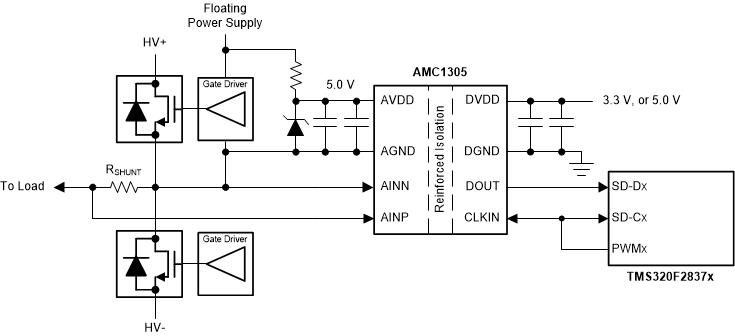TIDUE53I march 2018 – july 2023 TMS320F28P550SJ , TMS320F28P559SJ-Q1
- 1
- Description
- Resources
- Features
- Applications
- 6
- 1System Description
- 2System Overview
-
3Hardware, Software, Testing Requirements, and Test Results
- 3.1 Required Hardware and Software
- 3.2 Testing and Results
- 4Design Files
- 5Trademarks
- 6About the Authors
- 7Revision History
2.2.4 AMC1305M05
The AMC1305 device is a precision, delta-sigma (ΔΣ) modulator with the output separated from the input circuitry by a capacitive double isolation barrier that is highly resistant to magnetic interference. This barrier is certified to provide reinforced isolation of up to 7000 VPEAK according to the DIN V VDE V 0884-10, UL1577, and CSA standards. Used in conjunction with isolated power supplies, the device prevents noise currents on a high common-mode voltage line from entering the local system ground and interfering with or damaging low voltage circuitry.
- Pin-compatible family optimized for
shunt-resistor-based current measurements:
- ±50-mV or ±250-mV input voltage ranges
- CMOS or LVDS digital interface options
- Excellent DC performance supporting
high-precision sensing on system level:
- Offset error: ±50 µV or ±150 µV (max)
- Offset drift: 1.3 µV/°C (max)
- Gain error: ±0.3% (max)
- Gain drift: ±40 ppm/°C (max)
- Safety-related certifications:
- 7000-VPK reinforced isolation per DIN V VDE V 0884-10 (VDE V 0884-10): 2006-12
- 5000-VRMS isolation for 1 minute per UL1577
- CAN/CSA No. 5A-Component Acceptance Service Notice, IEC 60950-1, and IEC 60065 End Equipment Standards
- Transient immunity: 15 kV/µs (min)
- High electromagnetic field immunity (see ISO72x Digital Isolator Magnetic-Field Immunity )
- External 5-MHz to 20-MHz clock input for easier system-level synchronization
- Fully specified over the extended industrial temperature range
 Figure 2-5 AMC1305M05 Simplified
Schematic
Figure 2-5 AMC1305M05 Simplified
Schematic